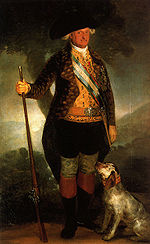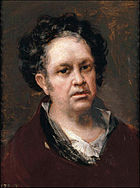- Charles IV in his Hunting Clothes
-
 Charles IV of Spain, 210cm x 130cm, Royal Palace of Madrid
Charles IV of Spain, 210cm x 130cm, Royal Palace of Madrid
Charles IV in his Hunting Clothes is an oil on canvas painting of 1799 by the Spanish artist Francisco Goya, the second of his two portraits of King Charles IV of Spain.[1] Goya had earlier been court painter to Charles III, who was widely viewed as the more astute political operator of the pair. While not lacking intelligence, Carlos IV is broadly seen as an idler compared to his father; ultimately he was out-maneuvered by Napoleon at a time when he was more interested in sport and hunting than affairs of state.
 Titian's Portrait of Charles V with a dog, 1533
Titian's Portrait of Charles V with a dog, 1533
While Goya devotes a great deal of attention to his depiction of the king's sash and cloth, he emphasises his weakness in his rendering of a near-portly belly and indecisive stare. The art critic Robert Hughes describes a "big nosed face, framed in the tricorned hat like the head of an affable turtle poking from its shell".[2] During his career, Goya depicted both father and son in hunting dress. The inspiration for the older man's outfit is probably taken from Velázquez's portrait of Philip IV, which the artist would have opportunity to see as then court painter. Goya pays tribute to Titian's Portrait of Charles V with a dog by depicting a dog loyally sniffing at the royal crotch.[3]
Goya had painted Carlos IV's father in 1780, when the artist himself was a young man.[2] Although few of his thoughts survive for art historians, it is generally believed that the sentiment of later works such as Charles IV of Spain and His Family lend credence to the theory that he held his weakling King in little regard. Charles IV is rendered as portly and sightly confused, seemingly more suited to the role of country gentleman than regal, absolute head.
Notes
Sources
- Boime. Albert. "Art in an age of Bonapartism, 1800-1815". Chicago University Press, 1993. ISBN 0-2260-6-336-4
- Connell, Evan S. Francisco Goya: A Life. New York: Counterpoint, 2004. ISBN 1-5824-3307-0
- Hagen, Rose-Marie & Hagen, Rainer. Francisco Goya, 1746-1828. Taschen, 2003. ISBN 3-8228-1823-2
- Hughes, Robert. Goya. New York: Alfred A. Knopf, 2004. ISBN 0-3945-8028-1
Francisco Goya List of works Paintings Blind Guitarist (1778) • Christ Crucified (1780) • Maria Teresa de Borbon y Vallabriga (1783) • Spring (or The Flower Girls) (1786–1787) • The Swing (1787) • St Francis Borja at the Deathbed of an Impenitent (1788) • Manuel Osorio de Zuniga (c. 1788) • Witches' Sabbath (1789) • Self-portrait (c. 1790–1795) • Little Giants (1791–1792) • Portrait of Mariana Waldstein (c. 1792) • Strolling Players (1793) • Yard with Lunatics (1793–1794) • Marquesa de la Solana (c. 1794–1795) • Duchess of Alba (1797) • Self-Portrait with Eyeglasses (1797) • The Bewitched Man (1797-1798) • The Devil's Lamp (1797-1798) • Witches' Flight (1797-98) • Charles IV in his Hunting Clothes (1799) • Countess of Chinchon (1800) • La maja desnuda • Charles IV of Spain and His Family (1800–1801) • La maja vestida • Bartolome Sureda y Miserol (c. 1803–1804) • Portrait of Doña Isabel de Porcel (1804–1805) • Portrait of Francisca Sabasa García (1804-1808) • Doña Teresa Sureda (c. 1805) • The Colossus (1808–1812; attribution debated) • Majas on a Balcony (c. 1808–1812) • Time (c. 1810–1812) • Prison Interior (c. 1810–1814) • The Second of May 1808 (1814) • The Third of May 1808 (1814) • The Junta of the Philippines (1815) • The Madhouse (1812-1819) • The Inquisition Tribunal (1812-1819) • The Burial of the Sardine (c. 1816) • A Procession of Flagellants (c. 1816) • The Forge (c. 1817) • The Giant (1818) • Self-portrait with Dr Arrieta (1820) • The Milkmaid of Bordeaux (1825–1827)
Tapestry cartoonsThe Parasol (c. 1777) • Blind man's bluff (1789)Saturn Devouring His Son • Judith and Holofernes • Witches' Sabbath • A Pilgrimage to San Isidro • La Leocadia • Two Old Men • Men Reading • Man Mocked by Two Women • Fight with Cudgels • Procession of the Holy Office • Atropos • Asmodea • Two Old Men Eating Soup • The Dog

Etchings The Sleep of Reason Produces Monsters (1797–1798) • What a sacrifice! (1797–1798) • They say yes and give their hand to the first comer (1797–1798) • Que se la llevaron! (1797–1798) • You who cannot (1797–1798)The Disasters of War
(Los desastres de la guerra)TauromaquiaUnfortunate events in the front seats of the ring of Madrid, and the death of the Mayor of Torrejón (1815–1816)Categories:- 1799 paintings
- Francisco Goya portraits
- 18th-century portraits
Wikimedia Foundation. 2010.
